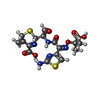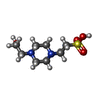登録情報 データベース : PDB / ID : 1xkzタイトル Crystal structure of the acylated beta-lactam sensor domain of Blar1 from S. aureus Regulatory protein blaR1 キーワード / / 機能・相同性 分子機能 ドメイン・相同性 構成要素
/ / / / / / / / / / 生物種 Staphylococcus aureus (黄色ブドウ球菌)手法 / / / 解像度 : 1.75 Å データ登録者 Birck, C. / Cha, J.Y. / Cross, J. / Schulze-Briese, C. / Meroueh, S.O. / Schlegel, H.B. / Mobashery, S. / Samama, J.-P. ジャーナル : J.Am.Chem.Soc. / 年 : 2004タイトル : X-ray crystal structure of the acylated beta-lactam sensor domain of BlaR1 from Staphylococcus aureus and the mechanism of receptor activation for signal transduction著者 : Birck, C. / Cha, J.Y. / Cross, J. / Schulze-Briese, C. / Meroueh, S.O. / Schlegel, H.B. / Mobashery, S. / Samama, J.-P. 履歴 登録 2004年9月30日 登録サイト / 処理サイト 改定 1.0 2004年11月30日 Provider / タイプ 改定 1.1 2008年4月30日 Group 改定 1.2 2011年7月13日 Group 改定 1.3 2024年4月3日 Group Data collection / Database references ... Data collection / Database references / Derived calculations / Refinement description カテゴリ chem_comp_atom / chem_comp_bond ... chem_comp_atom / chem_comp_bond / database_2 / pdbx_initial_refinement_model / struct_conn / struct_site Item _database_2.pdbx_DOI / _database_2.pdbx_database_accession ... _database_2.pdbx_DOI / _database_2.pdbx_database_accession / _struct_conn.pdbx_leaving_atom_flag / _struct_conn.ptnr1_auth_comp_id / _struct_conn.ptnr1_auth_seq_id / _struct_conn.ptnr1_label_asym_id / _struct_conn.ptnr1_label_atom_id / _struct_conn.ptnr1_label_comp_id / _struct_conn.ptnr1_label_seq_id / _struct_conn.ptnr2_auth_comp_id / _struct_conn.ptnr2_auth_seq_id / _struct_conn.ptnr2_label_asym_id / _struct_conn.ptnr2_label_atom_id / _struct_conn.ptnr2_label_comp_id / _struct_conn.ptnr2_label_seq_id / _struct_site.pdbx_auth_asym_id / _struct_site.pdbx_auth_comp_id / _struct_site.pdbx_auth_seq_id 改定 1.4 2024年11月13日 Group カテゴリ / pdbx_modification_feature
すべて表示 表示を減らす
 データを開く
データを開く 基本情報
基本情報 要素
要素 キーワード
キーワード 機能・相同性情報
機能・相同性情報
 X線回折 /
X線回折 /  シンクロトロン / rigid body refinement / 解像度: 1.75 Å
シンクロトロン / rigid body refinement / 解像度: 1.75 Å  データ登録者
データ登録者 引用
引用 ジャーナル: J.Am.Chem.Soc. / 年: 2004
ジャーナル: J.Am.Chem.Soc. / 年: 2004 構造の表示
構造の表示 Molmil
Molmil Jmol/JSmol
Jmol/JSmol ダウンロードとリンク
ダウンロードとリンク ダウンロード
ダウンロード 1xkz.cif.gz
1xkz.cif.gz PDBx/mmCIF形式
PDBx/mmCIF形式 pdb1xkz.ent.gz
pdb1xkz.ent.gz PDB形式
PDB形式 1xkz.json.gz
1xkz.json.gz PDBx/mmJSON形式
PDBx/mmJSON形式 その他のダウンロード
その他のダウンロード 1xkz_validation.pdf.gz
1xkz_validation.pdf.gz wwPDB検証レポート
wwPDB検証レポート 1xkz_full_validation.pdf.gz
1xkz_full_validation.pdf.gz 1xkz_validation.xml.gz
1xkz_validation.xml.gz 1xkz_validation.cif.gz
1xkz_validation.cif.gz https://data.pdbj.org/pub/pdb/validation_reports/xk/1xkz
https://data.pdbj.org/pub/pdb/validation_reports/xk/1xkz ftp://data.pdbj.org/pub/pdb/validation_reports/xk/1xkz
ftp://data.pdbj.org/pub/pdb/validation_reports/xk/1xkz リンク
リンク 集合体
集合体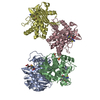

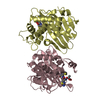
 要素
要素

 X線回折 / 使用した結晶の数: 1
X線回折 / 使用した結晶の数: 1  試料調製
試料調製 シンクロトロン / サイト:
シンクロトロン / サイト:  SLS
SLS  / ビームライン: X06SA / 波長: 0.9794 Å
/ ビームライン: X06SA / 波長: 0.9794 Å 解析
解析 ムービー
ムービー コントローラー
コントローラー




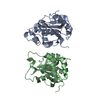
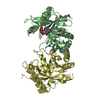
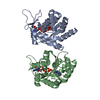

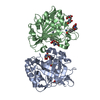

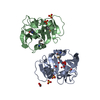
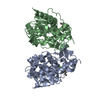
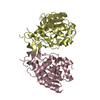
 PDBj
PDBj